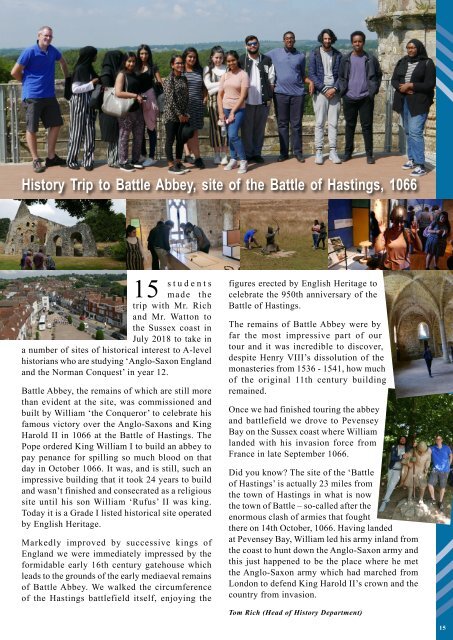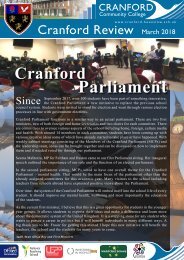Cranford Review 2018
The “Cranford Review” © is a publication of Cranford Community College. Is an annual high standard produced magazine which provides an archive document highlighting various aspects of the life of the academy, its staff, students and community from each academic year. It is a wonderful read and a useful historical document which, with its termly sister publications and occasional special editions, also serves to describe the values of the academy and support the aspirations of the academy, its staff, students and wider community. A colorful layout with a wide range of topics comprising events, extracurricular activities, recognition awards, initiatives, trips and excursions among many others. Hard copies are provided to stakeholders including families, staff, partners, visitors, prospective parents/students, prospective employees and others with an interest or stake in the academy and its students. Headteacher & Director: Kevin Prunty / Editor-in-chief: Jessica Joyce / Graphic Design: Enzo Gianvittorio Danese (Enzo GD) / Printed by: Springfieldpapers.com
The “Cranford Review” © is a publication of Cranford Community College. Is an annual high standard produced magazine which provides an archive document highlighting various aspects of the life of the academy, its staff, students and community from each academic year.
It is a wonderful read and a useful historical document which, with its termly sister publications and occasional special editions, also serves to describe the values of the academy and support the aspirations of the academy, its staff, students and wider community. A colorful layout with a wide range of topics comprising events, extracurricular activities, recognition awards, initiatives, trips and excursions among many others. Hard copies are provided to stakeholders including families, staff, partners, visitors, prospective parents/students, prospective employees and others with an interest or stake in the academy and its students.
Headteacher & Director: Kevin Prunty / Editor-in-chief: Jessica Joyce / Graphic Design: Enzo Gianvittorio Danese (Enzo GD) / Printed by: Springfieldpapers.com
Create successful ePaper yourself
Turn your PDF publications into a flip-book with our unique Google optimized e-Paper software.
History Trip to Battle Abbey, site of the Battle of Hastings, 1066<br />
15 students<br />
made the<br />
trip with Mr. Rich<br />
and Mr. Watton to<br />
the Sussex coast in<br />
July <strong>2018</strong> to take in<br />
a number of sites of historical interest to A-level<br />
historians who are studying ‘Anglo-Saxon England<br />
and the Norman Conquest’ in year 12.<br />
Battle Abbey, the remains of which are still more<br />
than evident at the site, was commissioned and<br />
built by William ‘the Conqueror’ to celebrate his<br />
famous victory over the Anglo-Saxons and King<br />
Harold II in 1066 at the Battle of Hastings. The<br />
Pope ordered King William I to build an abbey to<br />
pay penance for spilling so much blood on that<br />
day in October 1066. It was, and is still, such an<br />
impressive building that it took 24 years to build<br />
and wasn’t finished and consecrated as a religious<br />
site until his son William ‘Rufus’ II was king.<br />
Today it is a Grade I listed historical site operated<br />
by English Heritage.<br />
Markedly improved by successive kings of<br />
England we were immediately impressed by the<br />
formidable early 16th century gatehouse which<br />
leads to the grounds of the early mediaeval remains<br />
of Battle Abbey. We walked the circumference<br />
of the Hastings battlefield itself, enjoying the<br />
figures erected by English Heritage to<br />
celebrate the 950th anniversary of the<br />
Battle of Hastings.<br />
The remains of Battle Abbey were by<br />
far the most impressive part of our<br />
tour and it was incredible to discover,<br />
despite Henry VIII’s dissolution of the<br />
monasteries from 1536 - 1541, how much<br />
of the original 11th century building<br />
remained.<br />
Once we had finished touring the abbey<br />
and battlefield we drove to Pevensey<br />
Bay on the Sussex coast where William<br />
landed with his invasion force from<br />
France in late September 1066.<br />
Did you know? The site of the ‘Battle<br />
of Hastings’ is actually 23 miles from<br />
the town of Hastings in what is now<br />
the town of Battle – so-called after the<br />
enormous clash of armies that fought<br />
there on 14th October, 1066. Having landed<br />
at Pevensey Bay, William led his army inland from<br />
the coast to hunt down the Anglo-Saxon army and<br />
this just happened to be the place where he met<br />
the Anglo-Saxon army which had marched from<br />
London to defend King Harold II’s crown and the<br />
country from invasion.<br />
Tom Rich (Head of History Department)<br />
15

















